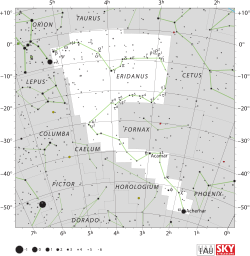Eridanus (constellation)
| Constellation | |

|
|
| Abbreviation | Eri |
|---|---|
| Genitive | Eridani |
| Pronunciation |
/ᵻˈrɪdənəs/ Erídanus, genitive /ᵻˈrɪdənaɪ/ |
| Symbolism | the river Eridanus |
| Right ascension | 3.25 |
| Declination | −29 |
| Family | Heavenly Waters |
| Quadrant | SQ1 |
| Area | 1138 sq. deg. (6th) |
| Main stars | 24 |
|
Bayer/Flamsteed stars |
87 |
| Stars with planets | 32 |
| Stars brighter than 3.00m | 4 |
| Stars within 10.00 pc (32.62 ly) | 13 |
| Brightest star | Achernar (α Eri) (0.46m) |
| Nearest star |
ε Eri (10.50 ly, 3.22 pc) |
| Messier objects | None |
| Meteor showers | None |
| Bordering constellations |
Cetus Fornax Phoenix Hydrus Tucana (corner) Horologium Caelum Lepus Orion Taurus |
|
Visible at latitudes between +32° and −90°. Best visible at 21:00 (9 p.m.) during the month of December. |
|
Eridanus (/ᵻˈrɪdənəs/) is a constellation in the southern hemisphere. It is represented as a river. It was one of the 48 constellations listed by the 2nd century astronomer Ptolemy, and it remains one of the 88 modern constellations. It is the sixth largest of the modern constellations. The same name was later taken as a Latin name for the real Po River and also for the name of a minor river in Athens.
At its southern end is the magnitude 0.5 star Achernar, designated Alpha Eridani. 144 light-years from Earth, it is a blue-white hued main sequence star whose traditional name means "the river's end". Achernar is a very peculiar star because it is one of the flattest stars known. Observations indicate that its radius is about 50% larger at the equator than at the poles. This distortion occurs because the star is spinning extremely rapidly.
There are several other noteworthy stars in Eridanus, including some double stars. Beta Eridani, traditionally called Cursa, is a blue-white star of magnitude 2.8, 89 light-years from Earth. Its place to the south of Orion's foot gives it its name, which means "the footstool". Theta Eridani, called Acamar, is a binary star with blue-white components, distinguishable in small amateur telescopes and 161 light-years from Earth. The primary is of magnitude 3.2 and the secondary is of magnitude 4.3. 32 Eridani is a binary star 290 light-years from Earth. The primary is a yellow-hued star of magnitude 4.8 and the secondary is a blue-green star of magnitude 6.1. 32 Eridani is divisible in small amateur telescopes. 39 Eridani is a binary star also divisible in small amateur telescopes, 206 light-years from Earth. The primary is an orange-hued giant star of magnitude 4.9 and the secondary is of magnitude 8. 40 Eridani is a triple star system consisting of an orange main-sequence star, a white dwarf, and a red dwarf. The orange main-sequence star is the primary of magnitude 4.4, and the white secondary of magnitude 9.5 is the most easily visible white dwarf. The red dwarf, of magnitude 11, orbits the white dwarf every 250 years. The 40 Eridani system is 16 light-years from Earth. p Eridani is a binary star with two orange components, 27 light-years from Earth. The magnitude 5.8 primary and 5.9 secondary have an orbital period of 500 years.
...
Wikipedia
